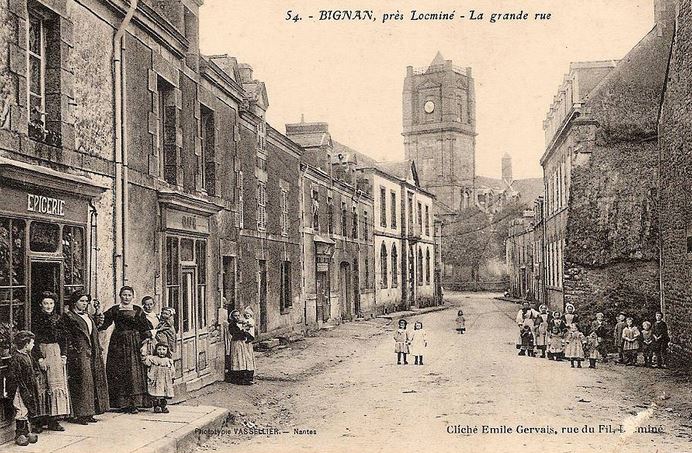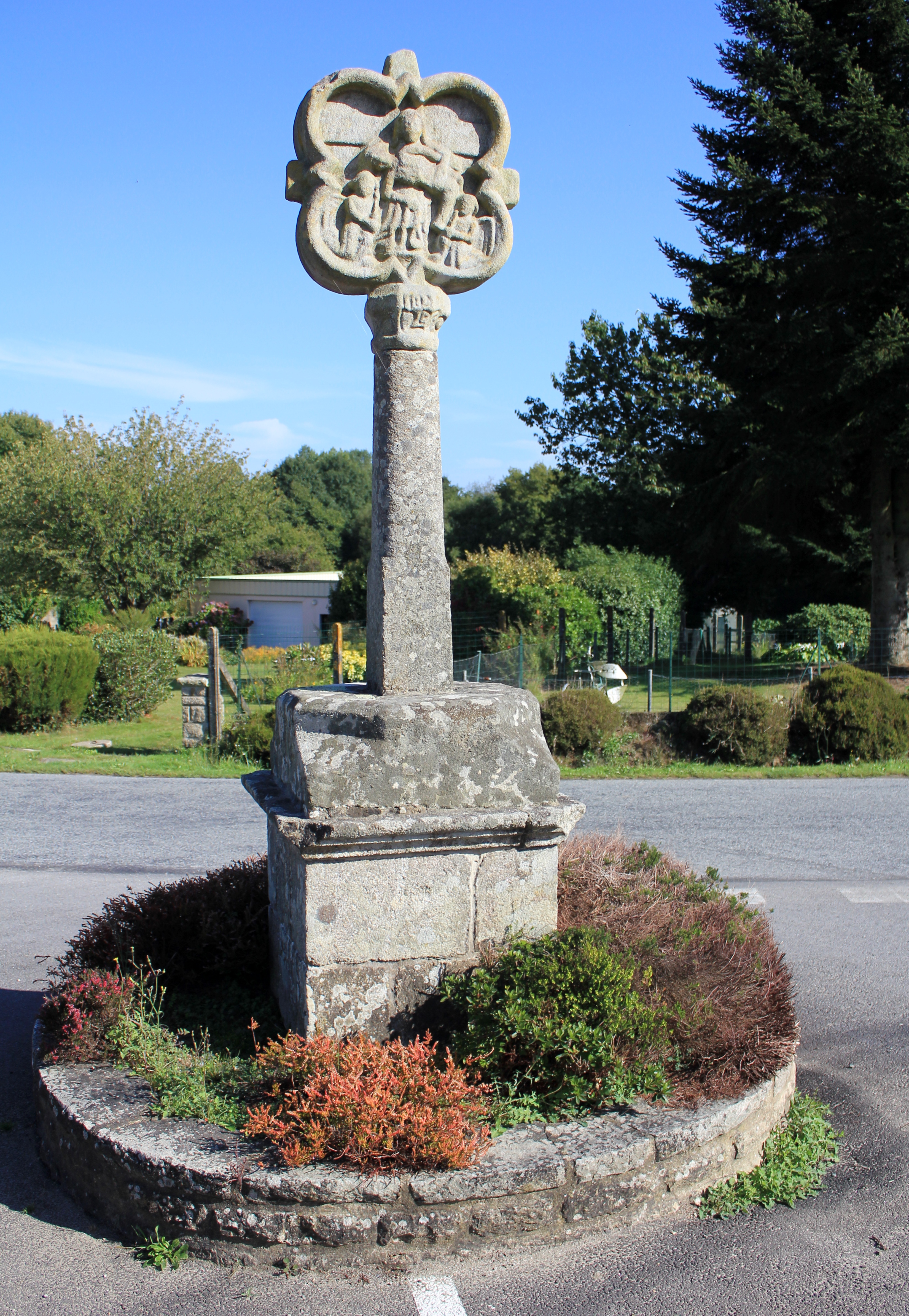Bignan on:
[Wikipedia]
[Google]
[Amazon]
Bignan (; ) is a commune in the
 In the 5th century Saint Noyale was said to be
In the 5th century Saint Noyale was said to be
 The Cross of Tenuel is located at a place called "Treuliec" in Bignan in Morbihan in the center of the town of Bignan (French department of Morbihan). The cross is of seventeenth century origin, rebuilt in 1897 and the cross has a medallion with four leaves representing the crucifixion on the front and a pietà verso. The plinth is carved. The cross is the subject of an inscription as a historical monument since 5 April 1935.
The Cross of Tenuel is located at a place called "Treuliec" in Bignan in Morbihan in the center of the town of Bignan (French department of Morbihan). The cross is of seventeenth century origin, rebuilt in 1897 and the cross has a medallion with four leaves representing the crucifixion on the front and a pietà verso. The plinth is carved. The cross is the subject of an inscription as a historical monument since 5 April 1935.
 The cross of the village of Bignan is located in Bignan, near the south
The cross of the village of Bignan is located in Bignan, near the south
''Enseignement bilingue''
/ref>
Mayors of Morbihan Association
{{Authority control Communes of Morbihan
Morbihan
The Morbihan ( , ; ) is a departments of France, department in the administrative region of Brittany (administrative region), Brittany, situated in the northwest of France. It is named after the Gulf of Morbihan, Morbihan (''small sea'' in Breton ...
department in Brittany
Brittany ( ) is a peninsula, historical country and cultural area in the north-west of modern France, covering the western part of what was known as Armorica in Roman Gaul. It became an Kingdom of Brittany, independent kingdom and then a Duch ...
in northwestern France
France, officially the French Republic, is a country located primarily in Western Europe. Overseas France, Its overseas regions and territories include French Guiana in South America, Saint Pierre and Miquelon in the Atlantic Ocean#North Atlan ...
.
Location
The town is based on the Landes de Lanvaux. Bignan is located between the townships of Locminé and Saint-Jean-Brévelay. Bignan is only half an hour from the main cities of Morbihan: Vannes, Lorient and Pontivy.History
 In the 5th century Saint Noyale was said to be
In the 5th century Saint Noyale was said to be martyr
A martyr (, ''mártys'', 'witness' Word stem, stem , ''martyr-'') is someone who suffers persecution and death for advocating, renouncing, or refusing to renounce or advocate, a religious belief or other cause as demanded by an external party. In ...
ed in or near the town.
In 1252, Guillaume de Bignan founded the nearby abbaye de prières.
The earliest mention of Bingnen is in 1421, Buignen in 1428, and Bignen in 1461. Bignen was formerly part of the deanery of Porhoët, of the fief of the lords of Rohan.
The town church
Church may refer to:
Religion
* Church (building), a place/building for Christian religious activities and praying
* Church (congregation), a local congregation of a Christian denomination
* Church service, a formalized period of Christian comm ...
was constructed between 1787 and 1801 with construction interrupted by the French Revolution.
Bignan was a very active center of chouannerie from 1794 by the action of Pierre Guillemot, called "the king of Bignan", lieutenant of Georges Cadoudal.
After the revolution Castle Kerguéhennec, sometimes nicknamed the " Versailles breton", served as a warehouse
A warehouse is a building for storing goods. Warehouses are used by manufacturers, importers, exporters, wholesalers, transport businesses, customs, etc. They are usually large plain buildings in industrial parks on the rural–urban fringe, out ...
for the Chouans to remove crops to the law of requisition of grain applied by the Republican administration.
In 1906, traces of an Iron Age
The Iron Age () is the final epoch of the three historical Metal Ages, after the Chalcolithic and Bronze Age. It has also been considered as the final age of the three-age division starting with prehistory (before recorded history) and progre ...
settlements and in particular of the Acheulean period were found near the town.
At the start of the 2016 academic year, 49 students were enrolled in the Catholic bilingual stream (22% of children in the commune enrolled in primary school)
Name
The meaning of the towns toponym is obscure. Several hypotheses exist: *A Beg (either Beg-Hent - Beg-nein : end of the road or Naizin) but the nasalisation of Breton seems to oppose it. *A similar origin ("little Bethany ") *A Breton origin via the term Bedun meaning birch which is called beg beu today, there is actually a locality, the Bézo, which could confirm (bezo = birches) * An idea of height based on the Celtic radicals benn (Benian) and penn = height (approximation with pign: pignein (to rise). The village is indeed located on a height. In Breton the city is named Begnen. The municipality signed the charter Ya d'ar brezhoneg on 20 November 2009.Population
Inhabitants of Bignan are called ''Bignanais''. In 2017, the municipality had 2,791 inhabitants, an increase of 7% compared to 2007.Landmarks
Catholic Church
The Saint-Pierre-et-Saint-Paul church is aCatholic
The Catholic Church (), also known as the Roman Catholic Church, is the List of Christian denominations by number of members, largest Christian church, with 1.27 to 1.41 billion baptized Catholics Catholic Church by country, worldwid ...
church
Church may refer to:
Religion
* Church (building), a place/building for Christian religious activities and praying
* Church (congregation), a local congregation of a Christian denomination
* Church service, a formalized period of Christian comm ...
located in Bignan. It is dedicated to the apostle
An apostle (), in its literal sense, is an emissary. The word is derived from Ancient Greek ἀπόστολος (''apóstolos''), literally "one who is sent off", itself derived from the verb ἀποστέλλειν (''apostéllein''), "to se ...
s Peter
Peter may refer to:
People
* List of people named Peter, a list of people and fictional characters with the given name
* Peter (given name)
** Saint Peter (died 60s), apostle of Jesus, leader of the early Christian Church
* Peter (surname), a su ...
and Paul
Paul may refer to:
People
* Paul (given name), a given name, including a list of people
* Paul (surname), a list of people
* Paul the Apostle, an apostle who wrote many of the books of the New Testament
* Ray Hildebrand, half of the singing duo ...
.
The building was built at the end of the 18th century on the site of a ruined Romanesque church. On the initiative of the rector of the time, Pierre Nourry, and following his plans, the construction of a new church was begun in 1787.
The first stone was laid on 19 August 1787, but construction was interrupted during the French Revolution and the exile of Abbot Nourry, refractory, work resumed in 1801. Pierre Nourry is buried there at his death in 18043. New bells are melted for the church and received in 1807. The bell tower is built between 1824 and 1857.
The church - with the sacristy, the furniture that is integrated and the placier - is registered as a historic monument by order of 23 February 2016.
Cross of Tenuel
Village Cross
transept
A transept (with two semitransepts) is a transverse part of any building, which lies across the main body of the building. In cruciform ("cross-shaped") cruciform plan, churches, in particular within the Romanesque architecture, Romanesque a ...
of the church.
The cross has been registered as a historical monument since 29 March 1935.
The basement is an altar which is accessed by two steps. It is surmounted by a patted cross.
Fontaine Saint-Éloi
The fountain has been listed as a historic monument since 18 October 1944. The niche is surmounted by a shell. Access to the pool is via two steps.Château de Kerguéhennec
Château de Kerguéhennec, nicknamed the Versailles of Breton, is an 18th-century castle located in Bignan. Today it houses acontemporary art
Contemporary art is a term used to describe the art of today, generally referring to art produced from the 1970s onwards. Contemporary artists work in a globally influenced, culturally diverse, and technologically advancing world. Their art is a ...
center and a cultural meeting center. This castle has been classified and registered as a historical monument since October 1988.
Allée couverte de Kergonfalz
The Allée couverte de Kergonfalz is a stone structure near the town. The building is located at the crossroads of the Moustoir-Ac road and the road to the hamlet of Kergonfalz. It is located approximately 470 m as the crow flies to the north of the latter and 200 m southwest of the hamlet of Kergal1. About 50 m to the west, on the other side of the Moustoir-Ac road, stands the Kergonfalz dolmen. The covered alley dates from theNeolithic
The Neolithic or New Stone Age (from Ancient Greek, Greek 'new' and 'stone') is an archaeological period, the final division of the Stone Age in Mesopotamia, Asia, Europe and Africa (c. 10,000 BCE to c. 2,000 BCE). It saw the Neolithic Revo ...
, around 3000 to 2700 BC. The structure is classified as historical monuments by order of 10 January 1970.
Chapelle Sainte-Noyale
fontaine Sainte-Nolwenn
Breton language
In 2008, 17.36% of primary-school children attended bilingual schools. ''Ofis ar Brezhoneg''''Enseignement bilingue''
/ref>
See also
*Communes of the Morbihan department
The following is a list of the 249 Communes of France, communes of the Morbihan Departments of France, department of France.
The communes cooperate in the following Communes of France#Intercommunality, intercommunalities (as of 2025):
* Henri Gouzien, sculptor of Bignan War Memorial
References
External links
*Mayors of Morbihan Association
{{Authority control Communes of Morbihan